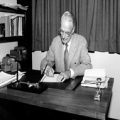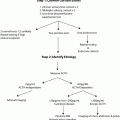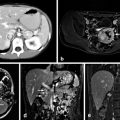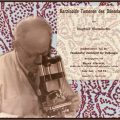Professor Eugen von Hippel. (Courtesy of VHL Family Alliance)
Introduction
An autosomal dominant familial cancer syndrome , von Hippel–Lindau (vHL), affects numerous organs, most prominently the central nervous system (CNS; angiomas and hemangioblastomas), the ear (endolymphatic sac tumors), the pancreas (cysts, microcystic adenomas, pancreatic neuroendocrine tumors), the adrenal glands (pheochromocytomas), and the kidneys (cysts and renal cell carcinoma). For over a century, our understanding of this disease has evolved from observational and linkage analysis to a more complete genetic and molecular picture of the pathogenesis of the syndrome. Recommendations for screening (clinical, imaging, and genetic) and management have evolved and new agents are being developed and are the subject of clinical trials. With all these advances, it is important to understand how this inherited cancer syndrome was first recognized and to appreciate the physicians whose astute observations laid the foundation for our current approaches and advances.
Eugen von Hippel was born in Königsberg, Germany (now Kaliningrad, Russian Federation), in 1867. Königsberg was a city on the eastern edge of Germany until it was captured by the Soviet Union at the close of World War II. Eugen was the son of Arthur von Hippel (1841–1916) a respected ophthalmologist and an early pioneer of corneal transplantation.
The younger von Hippel pursued formal education in some of the most prestigious institutions of his day. He studied in Giessen, Freiburg, Berlin, Heidelberg, and Göttingen, receiving his doctorate in medicine in 1890. Following medical school, he first pursued the study of pathology under the mentorship of Professor Arnold in Heidelberg. His primary focus at that time was on the effects of severe infections in cadavers. However, undoubtedly influenced by his father’s example, Eugen began to specialize in ophthalmology in 1892 under the guidance of Professor Theodore Leber. Leber is best known for his descriptions of congenital amaurosis and hereditary optic neuropathy.
While working with Leber, von Hippel became interested with disorders in the formation of the eye, notably hydrophthalamus, corneal defects, cataracts, corectopia, and finally angiomatosis of the retina. Given his background in pathology, he was fascinated not only with his anatomic observations of these conditions but also in a broader understanding on their pathogenesis and embryonic origins. His work led to his seminal publication in 1904 [1]. The work described in detail a very rare disease of the retina that von Hippel termed “angiomatosis retinae.”
Perhaps, what makes this work so impactful was not only von Hippel’s description of the physical manifestations in great detail but also his observations of a linkage to a possible hereditary cause through his documentation of the presence of this rare condition in members of the same families. These keen strengths of observation, documentation, and attention to detail made Eugen von Hippel a very well-respected professor and teacher in his own right. He was known to create a very rich learning environment in his clinic and in his laboratory. He was well respected by his students and staff for encouraging discussion and debate while maintaining an inclusive interaction, which was unusual for the time. He was not the typical professor of his era, as he welcomed being challenged. Dr. von Hippel was also known for being a caring and compassionate physician, often sought after to care for complicated problems.
Dr. von Hippel was devoted to his family. He was known for providing medical care to them for eye conditions as well as involving them in his work. One particular instance bears repetition as it illustrates the juxtaposition of work and family. When he was a child, Arthur von Hippel, Eugen’s nephew, broke his glasses while playing ball. A small piece of glass was in his eye and he was brought to his uncle’s laboratory to have it removed. While waiting in the laboratory for Dr. von Hippel to arrive, Arthur became bored and noticed a cage of monkeys in the back of the laboratory, no doubt subjects of an observational study. As young boys can often become victims of their own curiosity, the door to the cage was opened, and the monkeys quickly began to exercise their freedom by rampaging throughout the laboratory. When Dr. von Hippel arrived, he too had to exercise both literally to catch the monkeys and figuratively in restraining his displeasure. As Arthur had successfully assisted in recapturing the monkeys, he was not disciplined.
Stay updated, free articles. Join our Telegram channel

Full access? Get Clinical Tree







